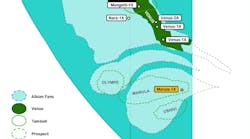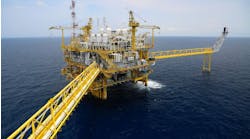Gulf of Mexico operators are allocating capex of more than $7 billion for deepwater field developments in 2007, according to a recent study by Wood Mackenzie. Chevron, Hess, BP, BHP, and Shell are spending the largest share of this investment through 2010.
Deepwater production is an integral part of overall Gulf supply, turning in 70% of all oil production and nearly 40% of gas supply in 2005. For the first six months of 2006, deepwater accounted for 72% of all OCS oil production and 38% of gas supply. These percentages have been climbing since around 1990 and are expected to continue on this upward trend for the foreseeable future. The entire OCS accounts for approximately 30% of all US production and 21% of natural gas production.Managing Editor David Paganie put together a special report on deepwater GoM activity for this issue. Don’t miss his review and forecast, beginning on page 44.
The fear factor
Hindsight always throws up some interesting questions, and this is certainly apparent in reviewing the international oil market in 2006, saysMohammed Barkindo acting for the OPEC Secretary General. In his special report for Offshore’s review and forecast issue, he asks some intriguing questions:
Who would have thought, he asks, the OPEC Reference Basket that had been on the rise since 2Q 2004 would have fallen by more than $19/bbl in only two months, from a peak of $72.70/bbl on Aug. 8? This is the sharpest drop since 1991.
Who could have predicted, he asks, this past year’s geopolitical concerns in the Middle East or the partial closure of BP’s key Prudhoe oilfield in North America?
What all these events underline, says Barkindo, is the greater-than-ever significance attributed to energy security. See his outlook for oil price during 2007 beginning onpage 28.
North Sea resurgence
The UKCS has experienced a resurgence in exploration and appraisal (E&A) drilling over the last two years, and this looks likely to continue as the twin pressures created by the Fallow and Promote License initiatives continue to recycle acreage onto the market for commercial deals and re-licensing. That’s the conclusion Jim Hannon of Hannon Westwood, reaches in his analysis of the 2007 outlook for the North Sea.
The level of E&A well spuds is pegged in the range of 50-60 per annum by the availability of rigs and the ability of the industry to evaluate the numerous opportunities for investment, he says.
With the North Sea experiencing the highest levels of E&A investment since the late 1980s and the UK’s 24th Licensing Round expected to add to activity levels, there is a significant number of potential third-party drilling opportunities on the UKCS. Of particular interest, says Hannon, are the central and southern North Sea, where license holders plan to drill within the next 15 months or so. His analysis begins onpage 32.
The African draw
Increasingly, the need to diversify leads to Africa.
So saysAndrew Hayman of IHS, and it’s hard to argue with his conclusions.
There is competition, he notes, for African acreage, particularly from Asian national oil companies seeking to fuel their burgeoning economies. The China-Africa summit held in Beijing in November 2006 was as much about pragmatic trade links for securing oil and mineral supplies as it was about political gestures, Hayman says.
For IOCs, it is also the size of a potential discovery that commands interest. In Angola, Congo, and Nigeria, the possibility of material discoveries in excess of 100 MMboe (either in a single discovery or in a cluster) remains favorable and continues to make the region an investment magnet. Read Hayman’s compelling analysis of why West Africa is critical for IOC investors and is of growing attraction to NOCs. His article appears onpage 36.


